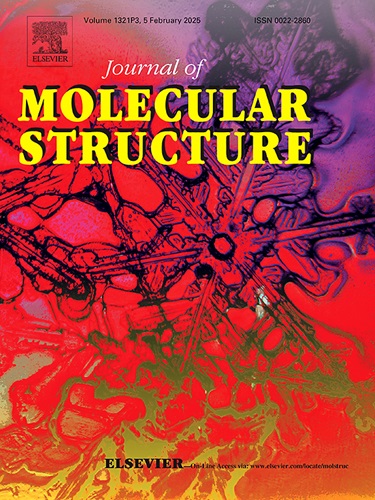基于{P2Mo5}的三维超分子框架,用于室温下硫化物到亚砜的高效转化
IF 4
2区 化学
Q2 CHEMISTRY, PHYSICAL
引用次数: 0
摘要
以standberg型[P2Mo5O23]6−(缩写为{P2Mo5})阴离子为基础,制备了一种超分子化合物[Zn(H2datrz)2(P2Mo5O23)(H2O)2]·10H2O(1),其中Hdatrz表示3,5-二氨基-1,2,4-三唑。单晶x射线衍射分析表明,化合物1具有三维蜂窝状结构,由{P2Mo5}阴离子、Zn2+阳离子和质子化的[H2datrz]+阳离子通过多次氢键相互作用构成。在催化硫化物选择性氧化生成亚砜的过程中,化合物1表现出较高的催化效率和对底物电子性质和位阻的广泛耐受性。特别是,化合物1在室温下仅20分钟就实现了毒性2-氯乙基乙基硫化物(CEES)近100%的转化,氧硫比(O/S)低至1.05。这一显著成果不仅突出了化合物1的催化效率,也体现了其实用性。此外,经过5次催化循环后,化合物1保持了结构的完整性和催化稳定性,证明了其作为可重复使用催化剂的有效性。本文章由计算机程序翻译,如有差异,请以英文原文为准。
{P2Mo5}-based 3D supramolecular framework for efficient sulfides to sulfoxides conversion at room temperature
A supramolecular compound [Zn(H2datrz)2(P2Mo5O23)(H2O)2]·10H2O (1) based on the Standberg-type [P2Mo5O23]6− (abbreviated as {P2Mo5}) anion has been prepared, where Hdatrz denotes 3,5-diamino-1,2,4-triazole. Single crystal X-ray diffraction analysis revealed that compound 1 possesses a three-dimensional (3D) honeycomb-like structure, which is constructed by the {P2Mo5} anions, Zn2+ cations, and protonated [H2datrz]+ cations through multiple hydrogen bonding interactions. In catalyzing the selective oxidation of sulfides to sulfoxides, compound 1 exhibited high catalytic efficiency and broad tolerance to the electronic properties and steric hindrance of the substrates. Particularly, compound 1 achieved nearly 100 % conversion of the toxic 2-chloroethyl ethyl sulfide (CEES) at room temperature in just 20 min and an oxygen-sulfur ratio (O/S) as low as 1.05. This remarkable achievement not only highlights the catalytic efficiency of compound 1 but also reflects its practicality. Furthermore, after five catalytic cycles, compound 1 maintained its structural integrity and catalytic stability, proving its effectiveness as a reusable catalyst.
求助全文
通过发布文献求助,成功后即可免费获取论文全文。
去求助
来源期刊

Journal of Molecular Structure
化学-物理化学
CiteScore
7.10
自引率
15.80%
发文量
2384
审稿时长
45 days
期刊介绍:
The Journal of Molecular Structure is dedicated to the publication of full-length articles and review papers, providing important new structural information on all types of chemical species including:
• Stable and unstable molecules in all types of environments (vapour, molecular beam, liquid, solution, liquid crystal, solid state, matrix-isolated, surface-absorbed etc.)
• Chemical intermediates
• Molecules in excited states
• Biological molecules
• Polymers.
The methods used may include any combination of spectroscopic and non-spectroscopic techniques, for example:
• Infrared spectroscopy (mid, far, near)
• Raman spectroscopy and non-linear Raman methods (CARS, etc.)
• Electronic absorption spectroscopy
• Optical rotatory dispersion and circular dichroism
• Fluorescence and phosphorescence techniques
• Electron spectroscopies (PES, XPS), EXAFS, etc.
• Microwave spectroscopy
• Electron diffraction
• NMR and ESR spectroscopies
• Mössbauer spectroscopy
• X-ray crystallography
• Charge Density Analyses
• Computational Studies (supplementing experimental methods)
We encourage publications combining theoretical and experimental approaches. The structural insights gained by the studies should be correlated with the properties, activity and/ or reactivity of the molecule under investigation and the relevance of this molecule and its implications should be discussed.
 求助内容:
求助内容: 应助结果提醒方式:
应助结果提醒方式:


